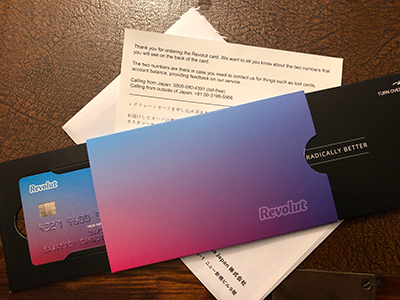日本文が後ろに続きます。
I live in Japan. I have bank accounts in Japan to get a monthly income and make regular payments. Besides, I have bank accounts in the United States and Hong Kong to put some of my money into different banks in different places with different currencies to minimize the risk. I manage my assets in these countries because there are more options for investment than in Japan.
A consideration is how to transfer the money you get in Japan to a foreign bank account. Wire transfer at a banking institute in Japan costs very much. I tried some online international money transfer services. All of these services require no less than 2,000 JPY of fee per transaction, so sending tens of thousand Yen with these services is costly.
Having two Paypal accounts can resolve this problem. I got two Paypal accounts with my different email addresses and linked one of the Paypal accounts to a debit card of the bank account in Japan and the other to the bank account in the US. When money was credited to the Japan bank account, I logged in to the Paypal account linked to the debit card and sent money with the debit card to the Paypal account linked to the US bank account. Then I logged out and logged in to the other Paypal account, and I withdrew money credited to the account to the US bank account linked to the Paypal account. The fee is cheaper as long as you send a small amount of money. However, you cannot send money from Japan to Hong Kong because if you live in Japan, your Paypal account does not allow you to link to any bank accounts in Hong Kong.
Table of Contents 目次
Revolut
Revolut resolves all of the problems. Revolut is a multi-currency banking service launched in the United Kingdom in 2015, and the service for residents in Japan became available this year. If you live in Japan, you can apply for a Revolut account via its smartphone app with your email address, credit/debit cards (AMEX is not supported, though), and your My Number Card. Once you open the account, you can top up money with one of the credit/debit cards used for the registration. The topped-up cash is credited to the account in Japanese Yen, and this cash is exchangeable to more than 150 currencies, including United States Dollar and Hong Kong Dollar. By registering bank accounts, you can withdraw (or pay) the money to one of the bank accounts. You can withdraw USD currency to US banks, and HKD to Hong Kong banks. That is, you can send Japanese Yen to US banks and Hong Kong banks in each currency used in the country the bank belongs to, with an exchange fee only. You can send money to someone else’s bank account as well.
Physical and virtual cards

Another characteristic of Revolut is its physical VISA debit card you can have issued and sent to your residential address for free (a fee may be charged depending on card face type). The plastic card looks almost the same as a credit card and is usable like a credit card for the payment of up to the amount you credited to the account. Unlike other debit cards issued in Japan, this card is embossed, so it is usable with an analog credit card imprinter. Of course, the card has an IC chip so that you can use the card with the four-digit PIN you registered in advance, without signing manually on a credit card slip.
A virtual card is also available for online use. If you find your physical or virtual card fraudulently used, you can deactivate it via the app at any time.
Cons
Unfortunately, Revolut has some drawbacks. If you are a resident of Japan, you cannot send cash to Japan’s banks, and you cannot top-up in foreign currencies from foreign banks. It means that you can only send money from Japanese banks to foreign banks, not vice versa. You cannot register the physical or virtual cards to Apple Pay.
Conclusion
Despite these drawbacks, Revolut is one of the successful cases of fintech and is the best solution for international money transfer and prepaid card service. I’m going to use it for the time being, and I’ll give feedback on this blog later.
私は日本で給料をもらって暮らしていますが、リスクヘッジと多様な運用をするためにアメリカと香港に銀行の口座を持っており、資産分散しています。
日本で得た円をどうやってこれらの銀行に送金するかが考慮事項なのですが、日本の銀行で海外送金をするとコストがものすごくかかるので、オンラインの海外送金サービスをいくつか試してみましたが、どれも1回2000円ぐらいの手数料はどうしてもかかってしまいます。まとまったお金を送金するのならいいのですが、数万円程度のお金を送るのにこれではもったいない気がします。
この問題はペイパルのアカウントを2つ持てば解決できます。別々のメールアドレス2つを使ってペイパルのアカウントを2つ申し込み、片方のアカウントに日本の銀行のデビットカードを登録し、もう片方にアメリカの銀行口座をひもづけます。そして日本の銀行のデビットカードを登録したアカウントにログインして、そのデビットカード払いで、アメリカの銀行口座があるほうのアカウント宛に送金(支払い)をします。そのあとログアウトしてもう一つのアカウントにログインすると、送金した分のお金が(手数料を惹かれた形で)入金されているので、それを米ドルに両替して、登録したアメリカの銀行口座に引き出すということをすれば、少額の送金なら手数料が安くてすみます。ただし日本在住者は香港の銀行はひもづけられないようなので、このやり方では香港の銀行に送金することはできません。
Revolut
Revolutを使えば、この問題がすべて解決できます。Revolutとは、2015年にイギリスで創業したマルチカレンシーのバンキングサービスで、今年から日本でもサービス開始になりました。日本在住者は、メールアドレスとクレジットカードまたはデビットカード(AMEXは対象外)、それから自分のマイナンバーカードがあれば、スマートフォンのアプリからアカウントを申請することができます。アカウントを開設したあとは、登録に使用したクレジットカードまたはデビットカードからお金をチャージすることができます。チャージした現金は日本円でアカウントに追加され、米ドル、香港ドルなど150種類以上の通貨に両替することができます。銀行口座を登録することで、アカウントに入っている通貨をその口座宛に引き出す(または支払う)ことができます。米ドル通貨はアメリカの銀行宛に、香港ドルの通貨は香港の銀行宛に引き出すことが可能です。つまり、日本円をアメリカや香港の銀行宛に、両替手数料だけでそれぞれの国の通貨にして送金することができるというわけです。送金は自分の口座あてだけでなく、他の人の口座宛にすることもできます。
物理カードとバーチャルカード

Revolutのもうひとつの特長は、VISAデビットカードを物理的なカードで発行し、無料で自宅へ発送してもらえることです(カードタイプによって手数料がかかることがあります)。カードはクレジットカードとほとんど同じ外観で、アカウントに入っている金額の範囲内でクレジットカードと同じように支払いに使うことができます。他の日本で発行されるデビットカードと違うのは、このカードはエンボスされているので、アナログのインプリンターにも使えるというところです。もちろんICチップもついているので、あらかじめ登録した4桁のPIN番号を入れれば、サインレスで決済できます。
オンラインの利用用にバーチャルカードも発行できます。物理カードもバーチャルカードも、不正利用されたと思ったらアプリ上からいつでも利用停止処理ができます。
欠点
残念ながら欠点もいくつかあり、日本在住者は日本の銀行宛に送金できないのと、外国の銀行から外貨でチャージができないという点があります。それはつまり、日本の銀行から外国の銀行への送金はできても、その逆はできないということです。また物理カードやバーチャルカードはApple Payへの登録はできません。
まとめ
とはいえ、Revolutはフィンテックの成功事例の1つであり、国際送金サービスやプリペイドカードのサービスのベストソリューションであることには違いありません。しばらく使ってみて、またこのブログにフィードバックしたいと思います。

Leave a Reply